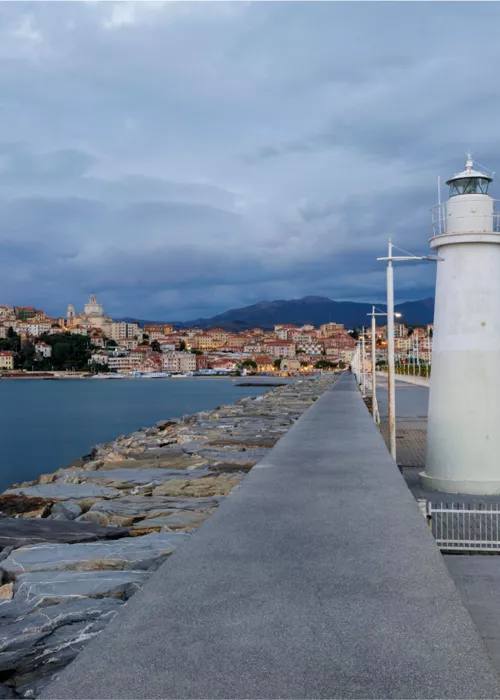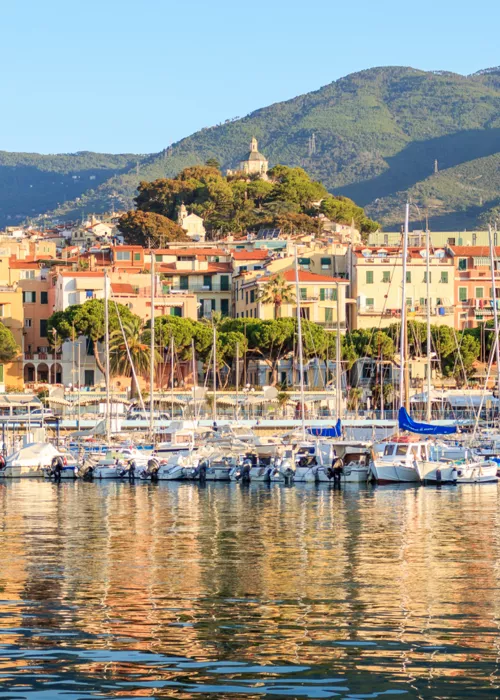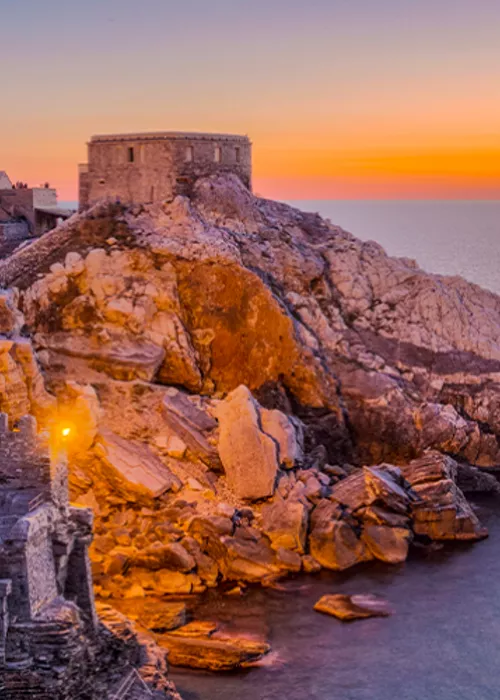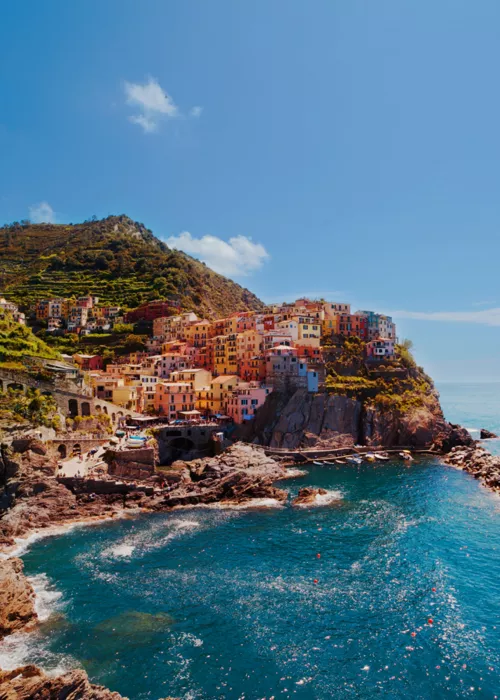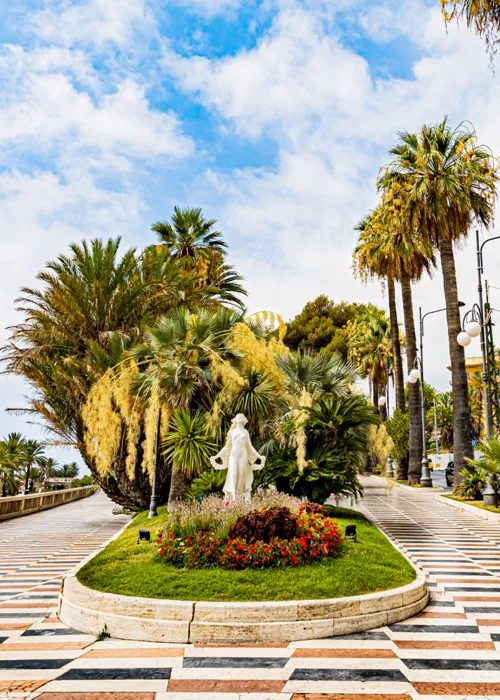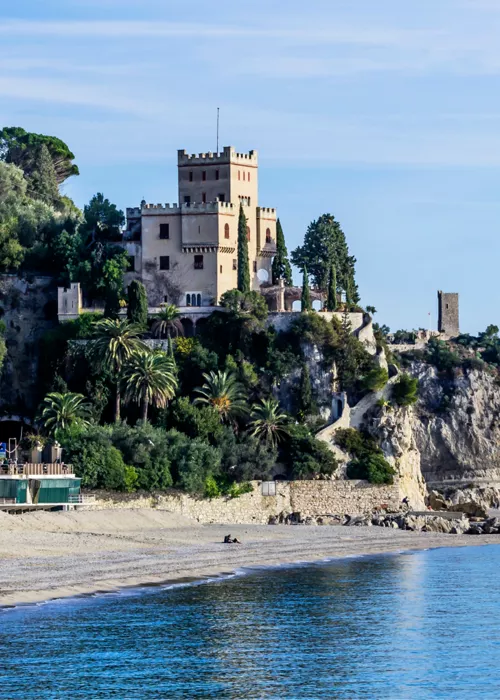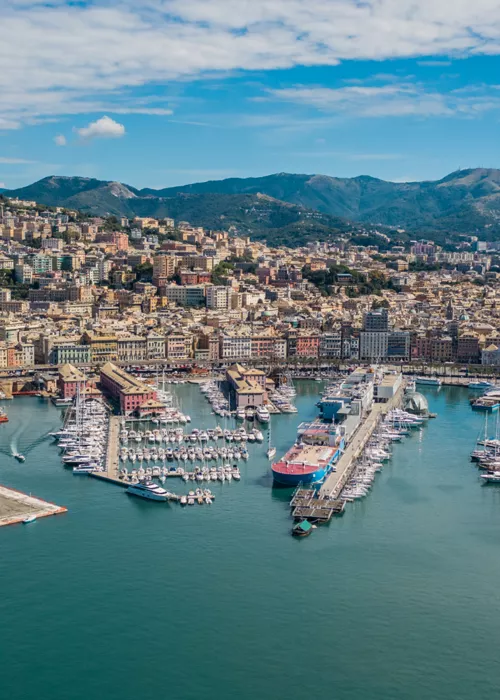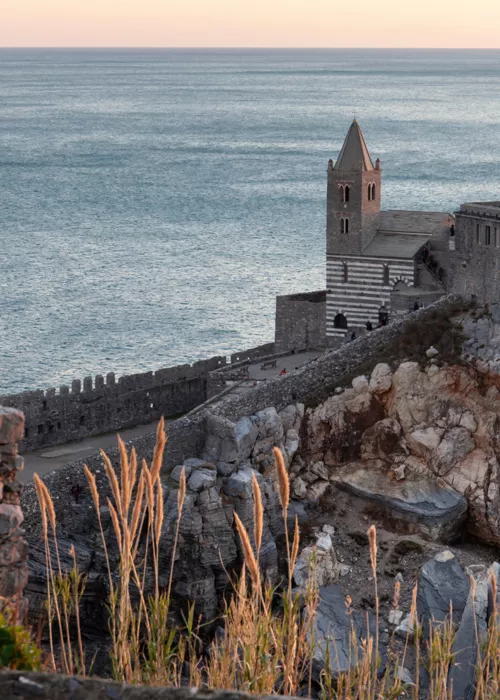From Imperia-Porto Maurizio to Imperia-Oneglia

Sailing along the Poets' Route we reach Porto Maurizio, already visible from the sea, with its characteristic houses clinging to the hill on which the neoclassical Cathedral, inspired by Roman and Genoese prototypes, stands, attracted by the bright Mediterranean colours of the agglomeration of medieval origin - the Parasio (a term derived from the Latin "palatium", referring to the early medieval building where justice and political affairs were administered) - goes up the hill to the Cathedral of San Maurizio, a neoclassical building built on an earlier baroque structure. From here, the urban and coastal itinerary begins, descending through a maze of typically Mediterranean streets to reach the Vespucci seafront, a beautiful promenade, some sections of which are part of the "Ponente ligure" cycle path, which runs from Imperia to Ospedaletti, created on the old railway line, now abandoned, 24 km of nature and relaxation, ideal for training and sport. From here you can cycle along the Ponente coast and reach the beautiful village of Ospedaletti. In the gallery before Ospedaletti there is a series of panels on the history of the famous Milan - Sanremo cycling race. Along the route there are numerous access points to beaches, refreshment points and bike hire. Returning to our itinerary for the Oneglia stage, after crossing the Impero torrent, along Via de Sonnaz, we reach Piazza Dante, of Savoy layout, with the tower and the clock, and the historical heart of Oneglia.
From Imperia-Oneglia and Montegrazie

We continue our journey from Oneglia, the modern and dynamic heart of Imperia. Here are the main commercial arteries of the city and the old fishermen's houses of Calata Cuneo, now home to fishmongers and many typical restaurants. A curiosity: Imperia is the protagonist of the first 10 minutes of 'The Bourne Identity'. Matt Damon is found injured and amnesiac by a fishing boat on the coast and is taken directly to the Oneglia pier. Walking along, you can see the outlines of the colourful fishermen's houses. Not far from Piazza Dante, in Via Garessio 13, is the Olive Museum, founded by the Fratelli Carli family: a very interesting journey through the beating heart of olive oil production, told through tools and numerous archaeological finds. On the hill is Villa Grock, former residence of the famous Swiss clown and home to the Clown Museum, characterised by a fairytale and scenic garden.
From Montegrazie to the village of Moltedo

From Oneglia, at the foot of the Impero stream, you can take the route already included in the Liguria excursion network, which climbs through a landscape of olive groves and rural farmhouses to the mediaeval sanctuary of Montegrazie, which dominates the entire Porto Maurizio valley. The beautiful building in Lombard Romanesque style is said to have been built on the site of the first altar dedicated to the Virgin Mary, which was erected here in the 13th century after the apparition of the Madonna to a young deaf-mute girl who was cured after the encounter. The sanctuary that can be visited today dates from 1450 and is characterised by a high bell tower and a stone façade. Inside you can admire an extraordinary cycle of frescoes, the work of Tomaso and Matteo Biazaci, depicting the Last Judgement, the Punishments of the Damned and the Stories of St. John the Baptist. In the niche of the main altar of the Sanctuary there is another work of great value, the refined marble statue of the Madonna, crowned on 8 September 1896, the date on which the Festival of Montegrazie is celebrated every year. On 11 April 1910 the 26th President of the United States of America and Nobel Peace Prize winner Theodore Roosevelt visited this beautiful sanctuary and it is said that he got out of the carriage to walk the last part of the way, enchanted by the beauty of the landscape and the sacred place. Roosevelt's visit is commemorated by two plaques on the outside wall of the sanctuary. Climbing up the coast you reach the village of Moltedo.
From the village of Moltedo to the village of Caramagna Ligure

The itinerary continues from the picturesque village of Moltedo, a pearl among the Ligurian hills. Here stands the Church of San Bernardo, a historic building with a sober and elegant façade. Inside, visitors can admire a precious 16th century wooden triptych, a work of art that depicts sacred scenes with a craftsmanship that speaks of centuries gone by. Leaving the tranquillity of Moltedo behind, the route descends along panoramic paths that offer breathtaking views of the surrounding valleys. As you approach the town of Caramagna Ligure, the landscape is enriched by centuries-old olive groves and fragrant citrus groves that accompany the journey with their characteristic scent. In Caramagna you will find the Sentiero Liguria, one of the most fascinating routes of the Riviera di Ponente. From this point, the itinerary includes a detour to the west, which takes walkers on a journey back in time. After a few kilometres you will find yourself in front of the suggestive mediaeval bridge of San Martino, a masterpiece of ancient architecture that stands majestically over the Caramagna stream. The bridge, with its stone arches, tells the story of a bygone era and blends in perfectly with the natural surroundings. Next to the bridge is the Oratory of San Martino, a small jewel of spirituality that invites you to pause for reflection and contemplation. Here the silence is broken only by the sound of the water flowing slowly under the bridge, creating a serene and magical atmosphere. Continuing the journey, the path winds through the hills and Ligurian villages, offering the opportunity to immerse yourself in unspoilt nature and a culture rich in tradition.
From the village of Caramagna Ligure to Porto Maurizio

The itinerary continues towards Cantalupo, immersed in a landscape of stones and olive trees, between the Mediterranean breeze and the scent of essences, returning to the beautiful hamlet of Caramagna. Just 3 km from the historic centre of Porto Maurizio, the village is a place where the past lives on through its streets and historic buildings, offering visitors an authentic glimpse of Ligurian life. In the main square of Cantalupo you can admire the majestic Parish Church of Saints Simon and Judas and the Oratory of San Giovanni, an example of 17th and 18th century architecture of fine workmanship, which preserves inside precious pictorial works, offering a unique opportunity to admire works of art in an intimate and evocative context. In the nearby hamlet of Ricci, visitors can admire the magnificent Oratory of San Giacomo, a seventeenth-century building that represents another treasure of local religious architecture. Renowned for its beauty and the works of art it contains, the Oratory is a must for anyone visiting the area. After exploring Cantalupo and Ricci, the itinerary continues down the hill and through the picturesque hamlet of Massabovi. This part of the route offers breathtaking views of the surrounding countryside, with its cultivated terraces and dry-stone walls that characterise the Ligurian landscape. Finally, we reach the ancient Parasio, the fortified mediaeval historical centre of Porto Maurizio. The urban layout of the village, designed with a clear defensive function, is characterised by its narrow concentric streets, all connected by staircases. The itinerary ends in Porto Maurizio, a lively meeting point between sea and land. Here, visitors can relax overlooking the boats gently bobbing on the water and enjoy the local cuisine in the restaurants overlooking the sea, completing an unforgettable experience of nature, art and culture.



